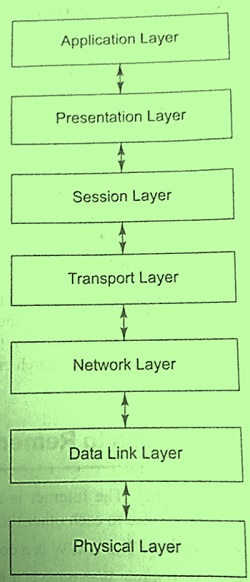Home »
Computer Network
Open System Interconnection (OSI) Model
Computer Network | OSI Model: In this tutorial, we will learn about the OSP model, its seven layers, and the its related functions performed.
By Abhishek Jain Last updated : April 26, 2023
What is Open System Interconnection (OSI) Model?
Open System Interconnection (OSI) is a layered design that defines the functions of the protocols used in a computer network. It consists of seven layers where each layer provides some services to the next layer.
Layers of Open System Interconnection (OSI) Model
The seven layers of the OSI model and the functions performed by them are as follows:

1. Application Layer
The application layer provides an interface through which users can communicate and transfer data on the network.
2. Presentation Layer
The presentation layer determines the way in which the data is presented to different computers. It converts the data into a particular format, which is supported by a specific computer. It is also responsible for encrypting, decrypting, compressing and decompressing of data.
3. Session Layer
The session layer manages the communication between the computers on the network. This layer is responsible for notifying the errors, which may have occurred in the layers above it. It is also responsible for setting up and breaking the connection between the computers or devices.
4. Transport Layer
The transport layer is responsible for the delivery of packets in a proper sequence. It also provides proper rectification of errors and manages the flow of packets over the network. This layer ensures that data is properly delivered at the destination. It also keeps track of all the packets, which fail to reach the destination, and transmits them again.
5. Network Layer
The Network Layer is responsible for identifying the ways in which the data is transmitted over the network from one device to another. It prevents the overloading of packets on the network and maintains the proper flow so that all the resources on the network can be used efficiently by all. The network layer directs the packets to the destination device on the basis of IP address of the device. It detects the errors, which occur during the transmission of packets. This layer is also responsible for breaking the large size packets into smaller packets when the device is unable to accept the packets due to their large size.
6. Data Link Layer
The data link layer specifies the actions, which must be performed to maintain the network communication. It collects the packets to form frames, which are then transmitted over the network. It also finds out and then corrects the errors, which occur during the transmission of packets.
7. Physical Layer
The Physical Layer describes all the physical requirements for the transmission of data between devices on a network. For example, the physical layer can specify the layout of pins, hubs and cables. This layer defines the relation between a single device and the transmission medium. It specifies the way in which a device must transmit data and also the way in which another device must receive data. This layer is responsible for the setting up and ending up of a network connection.